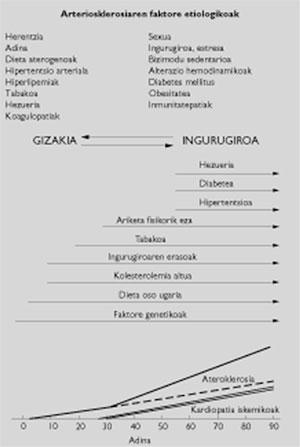Atherosclerosis Arteriosclerosis
1994/03/01 Agirre, Jabier - Medikua eta OEEko kidea Iturria: Elhuyar aldizkaria
Is it a new disease?
XVI. Since the twentieth century, the word is very cited in medical texts, depending always on the level of knowledge of each epoch. In addition, palaeopathology shows that arteriosclerotic lesions are present in human remains since their first antiquity (in an Egyptian mummy, that of an older woman, traces of arteriosclerosis have been found).
Anyway, what they knew about the disease was at the beginning in a certain way; until the end of the Middle Ages, until the XVI. Until the nineteenth century, autopsy was forbidden for religious reasons and most of the knowledge was based on mere empirical conviction. When autopsies began to be done in a relatively systematic way, different interpretations of the disease were published:
- The arteries, like the bones, were hardened. It would be something natural depending on age. Like the fontanelas of the newborn (junctions between bones of the skull) are ...
- Around 1830 the word arteriosclerosis arises to indicate thickening and hardening of the arteries, but thickening without ossification (proposed by Lobstein).
- According to another theory, the origin of the process would be inflammation.
- For others, however, these deposits would not be a consequence of an alteration in the blood.
At present, arteriosclerosis is a generic word used to affirm that the wall of the artery has been hardened and thickened. Within this denomination different types of lesions are admitted, as well as different types of arteriosclerosis: cerebral, senile, infantile, expansive or diffuse, peripheral, etc.
How does the disease arise?
The heart sends 5-30 liters of blood to the arteries of this small engine that keeps us alive every minute. The heart contracts about 70 times per minute, 100,000 times a day, 36 million a year and in a person of 70 years his heart contracts 2,500 million times.
This small and terrible engine, however, needs special responsibilities and, although the common goal is well-being, not everything goes so well on health issues, as cardiovascular diseases show: approximately half of the deaths that occur in advanced countries are due to cardiovascular diseases (in Europe it generates more than a million deaths per year).
The six main tips for preventing heart disease
- Stop smoking.
- Do not overeat. Take care of the weight.
- Reduce consumption of saturated fatty acids (fatty meats, bacon, sausages, dairy, butter and solid margarines). For cooking better vegetable oils (sunflower, e.g.) that butter or margarines.
- Avoid the bud.
- Take stress, being the appropriate frequency at the age of the person. But if the figures are at the limit of normality, more often than normal. And if the figures are hypertensive (that will be said by the doctor), make a diet low in salt and adequate medical control.
- Do some daily exercise to escape sedentarism: walking is highly recommended for all age groups.
The socio-economic problems that these diseases pose are also very serious, since when working it attacks people who still remain in their more temporary years. 20 years ago, for example, it was very rare for the infarction to be a person under the age of 50. At present, this limit of solitude must be reduced to 35 years.
Arteriosclerosis, however, is more a pathological concept (question of autopsi, in other words) than a clinical concept. In the WHO dictionary of cardiological terms it is defined as “lesion of the internal wall of the arteries”, “with accumulations of fat and proliferation of fibrous tissue”. The wall of the blood vessel is thickened and hardened, and may ultimately result in obstruction or total obstruction.
Obtaining a major blood vessel will cause typical features of the disease to appear, but as long as the obstruction does not occur, life seems normal. Therefore, the calcified uteroma can be diagnosed radiologically, being accidentally found in a routine study, without any symptoms until then.
What symptoms does the disease give?
The most deadly “epidemic” of our time is cardiovascular disease. And it can not be said that it is only about problems of rich and/or executives, since they affect equally the labor or the garduña of the office. Today no one of the risk factors is free of these evils, although with an adequate life prevention is possible. Among the causes of death, in developed countries, the main causes are cardiovascular diseases and cancer. In non-developed countries, however, infectious diseases still reach 10%. Cause of death Cardiovascular diseases Cancer Flu and pneumonia Accidents Bronchitis, emphysema, asthma Cirrhosis hepatic Communicable diseases Diabetes mellitus Nephritis and nephrosis Tuberculosis Other causes Rate 43.3% 16.6% 5.9% 5.2% 4.3% 2.6% 2.1% 1.2% 0.9% 15% |
The most serious clinical manifestation is ischemic heart disease. Ischemic heart disease can be defined as a pathological situation in which the cardiac muscle does not receive enough blood (and in most cases this situation is usually due to obstruction of arteriosclerosis).
Hypertension is an excessive increase in blood pressure. When small arteries narrow, the resistance to blood flow is increasing and the work for the heart.
When these disorders affect brain circulation, a stroke occurs with sudden paralysis when brain blood supply is interrupted in a given area. There are several causes:
- Cerebral hemorrhage due to a small artery rupture (which is usually quite frequent in hypertensive people).
- Cerebral thrombosis. The blood clot or clot inside an artery disrupts the blood circulation of the brain causing serious lesions in the area that should irrigate the artery: hemiplegia or paralysis (usually unilateral). Cerebral thrombosis is the most normal reason for stroke (“head door”) and may be the appearance of some cardiovascular disease.
- Cerebral embolism. Normally a clot released from the heart obstructs a cerebral artery and appears as a stroke or atake.
Prevention. Can anything be done?

The damage to the arteriosclerosis occurs mainly in three groups of arteries: the arteries of the heart, the cerebral arteries and the arteries of the lower extremities, although the most normal location is the coronary (heart). And the most common manifestation of arteriosclerotic heart disease is, unfortunately, sudden death. Therefore, in these cases, prevalence can hardly be done.
However, and generally speaking, coronary heart disease encompasses angina of the chest and myocardial infarction. And for a better understanding, the process can be divided into two phases: the preclinical or asymptomatic phase is the first and the clinical phase is the subsequent phase.
From the preclinical phase (and this phase can be detected or diagnosed by the doctor in the stress test by ECG), it can pass directly to death (sudden death as the first clinical manifestation) or acute myocardial infarction (v. Elhuyar. Science and Technology, 68. nº) or unstable angina with crises that can last days or weeks (both at rest and in reduced efforts). These patients with unstable angina are more likely to reinfarction than those who have myocardial infarction first of all, so when angina is unstable it is when the maximum attention should be paid (rest, continuous study). If the process goes ahead, there is a chronic angina as a last danger.
Health Education Education
Risk factors should be preserved. Due to the variety of factors, the main objectives are to quit smoking, control hypertension and monitor cholesterol while maintaining normal levels.
Food education is of special importance and should be applied from the beginning. Let us remember, as curiosity, that in infants fed with a bottle, calcifications have been found in the iliac arteries (which of course can be repaired) in cases in which the feeding has been excessive and inadequate.
Disclosure of risk factors
Preventive health campaigns should be organized for people with the three main risk factors: study of blood pressure (for hypertents), maintenance of cholesterol (and also glucose) in the blood in normal numbers and promotion of anti-tobacco actions (for smokers). And encourage physical activity in the proper size and to the extent that it corresponds to each person.
Other risk factors are much lower: oral contraceptives (especially if the woman is a smoker), diabetes, obesity, sedentary life, stress, gout (high level of uric acid), prevention or family history.


Gai honi buruzko eduki gehiago
Elhuyarrek garatutako teknologia





